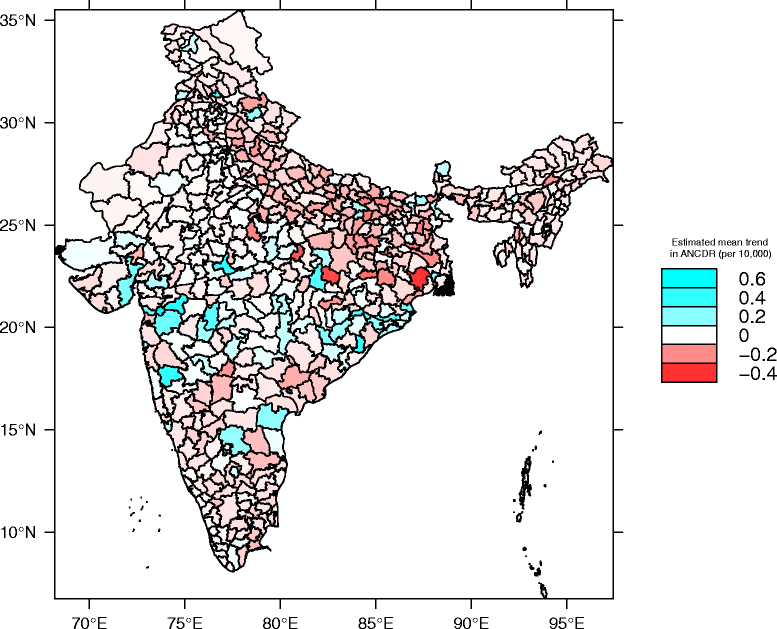
MMED 2016
Seventh annual Clinic on Meaningful Modeling of Epidemiological Data
African Institute for Mathematical Sciences, Muizenberg, Cape Town, South Africa
May 30 - June 10, 2016
Return to the Main Page.
Return to the Schedule.
Return to the list of potential projects.
Leprosy trends in India
Overview
Leprosy appears to be in gradual decline; however, it’s currently unclear whether it is declining in all locations where it occurs and whether or not the world will meet stated targets for leprosy control.
This group will fit transmission models to longitudinal data on the rates of detection of new cases, by district and state in India. We will also consider the fraction of cases in Grade II disability, which is a clinical category that can be used as a partial marker for delays in diagnosis.
Things to consider
- This group is recommended for:
- Students who want practice fitting dynamic models to data
- This group will have the opportunity to engage in any of the following:
- develop dynamic transmission models
- learn MCMC methods (use the Metropolis algorithm)
- learn how to evaluate forecasts by comparing measures of fit (for example, loglikelihood) on a test set
- Potential group members are encouraged to review the following sessions before before Week 2:
- Creating a model world to address a research question (Track B, Thursday AM)
- Introduction to statistical philosophy (Thursday AM)
- Introduction to likelihood (Thursday PM)
- In addition the following sessions during Week 2 will be essential for this group:
- Likelihood fitting and dynamic models II (Monday PM)
- Introduction to Markov Chain Monte Carlo methods (Tuesday AM)
Background
Leprosy is caused by a slow-growing _Mycobacterium_, related to the organism that causes tuberculosis. Most people never develop disease once exposed. For those who do, the incubation period is typically on the order of several years. Early symptoms may include numb patches of skin, and when the infection is left untreated, patients can develop irreversible eye and nerve damage. Irreversible effects - such as visible deformity, damage of the hands and feet, or inability to see with acuity better than 20/200 (or other ocular complications) - constitutes what is known as "Grade II" disability. Current WHO goals include reduction of Grade II disability from leprosy.
The disease is widely stigmatised (though apparently what we call "leprosy" today is not the same thing translated as "leprosy" from Biblical times) and many people fear the diagnosis. Many prefer the term "Hansen's disease" to "leprosy", emphasizing that the condition is, after all, simply another disease that can be treated. Although the infection is curable with antibiotics, and antibiotics can be freely obtained worldwide thanks to drug donations, for patients with Grade II disability, irreversible damage has generally occurred before the time of diagnosis. Early detection, treatment, and prevention are therefore essential to control efforts.
As we shall see, leprosy elimination efforts appear to have stalled in the last decade in many places, leading many to wonder what should be done, if anything, to speed up efforts to get rid of leprosy. At this time, key questions for public health policy are to understand whether or not the current targets for control will be met with current efforts, or whether enhanced case finding, contact investigation, or other procedures will be needed. More information about leprosy and leprosy elimination efforts is available from the WHO's website on the disease.Data
- The main source of data for this project will be public records from the India National Leprosy Eradication Program. Specifically, the data consist of annual, district-level new case detection rates and information on the number of cases with Grade II disability. The fraction of cases in children and the fraction of multibacillary cases (which is an indication of the severity of infection) are also available at the state level.
Resources
References
The following paper and commentary resulted from an MMED 2015 group project and are based on the same dataset that will form the basis of this project:
- Brook, CE, R Beauclair, O Ngwenya, L Worden, M Ndeffo-Mbah, TM Lietman, SK Satpathy, AP Galvani, and TC Porco (2015) Spatial heterogeneity in projected leprosy trends in India Parasites & Vectors 2015 8: 542
- Porco, TC (2016) Understanding leprosy trends. SACEMA Quarterly, March 10, 2016.
Tutorials
- Lab 5: Introduction to Likelihood
- Lab 8: MCMC fitting of a dynamic model

